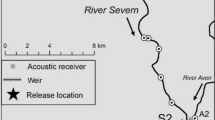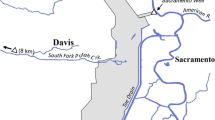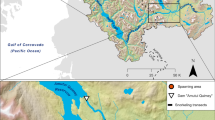Abstract
The frequency of reproduction and homing success are crucial in determining the lifetime reproductive fitness of iteroparous salmonids. We examined consecutive spawning and homing by Sakhalin taimen (Parahucho perryi), one of the least-studied iteroparous salmonids. The average consecutive return rate was 69.5%, the highest ever reported for an iteroparous salmonid. The consecutive return rates were highest for large spawners, females, and individuals with active inter-tributary movements in the preceding year. We estimated tributary-scale repeat homing rates to be 50–87%, which was significantly higher than expected by chance alone. The repeat homing rates were higher for spawners that entered tributaries with more abundant spawners in the preceding year, which is consistent with the pheromone hypothesis because the abundance of spawners in a tributary is expected to correlate to the concentration of chemical homing cues emanating from offspring in the following year. These extremely high consecutive return and homing rates likely facilitated local adaptation over evolutionary time scales and have contributed to population stability in this river system. These same traits, however, may impede species recovery following habitat restoration efforts within the species historic range (e.g. dam barrier removal or improved passage) due to their limited rate of dispersal.


Similar content being viewed by others
Data availability
The datasets generated during this study are available from the corresponding author on reasonable request.
References
Aarestrup K, Baktoft H, Thorstad EB, Svendsen JC, Höjesjö J, Koed A (2015) Survival and progression rates of anadromous brown trout kelts Salmo trutta during downstream migration in freshwater and at sea. Mar Ecol Prog Ser 535:185–195. https://doi.org/10.3354/meps11407
Armstrong RH (1974) Migration of anadromous Dolly Varden (Salvelinus malma) in Southeast Alaska. J Fish Res Board Can 31:435–444. https://doi.org/10.1139/f74-071
Berdahl A, Westley PAH, Quinn TP (2017) Social interactions shape the timing of spawning migrations in an anadromous fish. Anim Behav 126:221–229. https://doi.org/10.1016/j.anbehav.2017.01.020
Bett NN, Hinch SG (2015) Olfactory navigation during spawning migrations: a review and introduction of the hierarchical navigation hypothesis. Biol Rev 91:728–759. https://doi.org/10.1111/brv.12191
Binder TR, Riley SC, Holbrook CM, Hansen MJ, Bergstedt RA, Bronte CR, He J, Krueger CC (2016) Spawning site fidelity of wild and hatchery lake trout (Salvelinus namaycush) in northern Lake Huron. Can J Fish Aquat Sci 73:18–34. https://doi.org/10.1139/cjfas-2015-0175
Bond MH, Miller J, Quinn TP (2015) Beyond dichotomous life histories in partially migrating populations: cessation of anadromy in a long-lived fish. Ecology 96(7):1899–1910. https://doi.org/10.1890/14-1551.1
Bull JJ, Shine R (1979) Iteroparous animals that skip opportunities for reproduction. Am Nat 114:296–316. https://doi.org/10.1086/283476
Burnham KP, Anderson DR (2002) Model selection and multimodel inference: a practical information-theoretic approach, 2nd edn. Springer, New York
Dutil JD (1986) Energetic constraints and spawning interval in the anadromous Arctic charr (Salvelinus alpinus). Copeia 1986(4):945–955. https://doi.org/10.2307/1445291
Edo K, Kawaguchi Y, Nunokawa M, Kawamula H, Higashi S (2005) Morphology, stomach contents and growth of the endangered salmonid, Sakhalin taimen Hucho perryi, captured in the Sea of Okhotsk, northern Japan: evidence of an anadromous form. Environ Biol Fish 74:1–7. https://doi.org/10.1007/s10641-004-6115-z
Fausch KD, Baxter CV, Murakami M (2010) Multiple stressors in north temperate streams: lessons from linked forest-stream ecosystems in northern Japan. Freshwater Biol 55(Suppl 1):120–134. https://doi.org/10.1111/j.1365-2427.2009.02378.x
Fleming IA (1998) Pattern and variability in the breeding system of Atlantic salmon (Salmo salar), with comparisons to other salmonids. Can J Fish Aquat Sci 55(Suppl 1):59–76. https://doi.org/10.1139/d98-009
Fukushima M (2001) Salmonid habitat–geomorphology relationships in low-gradient streams. Ecology 82(5):1238–1246. https://doi.org/10.2307/2679985
Fukushima M, Harada C, Yamakawa A, Iizuka T (2019) Anadromy sustained in the artificially land-locked population of Sakhalin taimen in northern Japan. Environ Biol Fish 102(9):1219–1230. https://doi.org/10.1007/s10641-019-00904-4
Fukushima M, Shimazaki H, Rand PS, Kaeriyama M (2011) Reconstructing Sakhalin taimen Parahucho perryi historical distribution and identifying causes for local extinctions. Trans Am Fish Soc 140:1–13. https://doi.org/10.1080/00028487.2011.544999
Gallagher CP, Howland KL, Sandstrom SJ, Halden NM (2018) Migration tactics affect spawning frequency in an iteroparous salmonid (Salvelinus malma) from the Arctic. PLoS ONE 13(12):e0210202. https://doi.org/10.1371/journal.pone.0210202
Hamann EJ, Kennedy BP (2012) Juvenile dispersal affects straying behaviors of adults in a migratory population. Ecology 93:733–740. https://doi.org/10.1890/11-1009.1
Haraldstad T, Höglund E, Kroglund F, Lamberg A, Olsen EM, Haugen TO (2018) Condition-dependent skipped spawning in anadromous brown trout (Salmo trutta). Can J Fish Aquat Sci 75:2313–2319. https://doi.org/10.1139/cjfas-2017-0076
Hasler AD, Wisby WJ (1951) Discrimination of stream odors by fishes and its relation to parent stream behavior. Am Nat 85:223–238. https://doi.org/10.1086/281672
Helle JH (1966) Behavior of displaced adult pink salmon. Trans Am Fish Soc 95(2):188–195. https://doi.org/10.1577/1548-8659(1966)95[188:BODAPS]2.0.CO;2
Holčík J, Hensel K, Nieslanik J, Skácel L (1988) The Eurasian Huchen, Hucho hucho. Largest salmon of the world. Dr. W Junk Publishers, Dordrecht
Honda K, Arai T, Takahashi N, Miyashita K (2010) Life history and migration of Sakhalin taimen, Hucho perryi, caught from Lake Akkeshi in eastern Hokkaido, Japan, as revealed by Sr:Ca ratios of otoliths. Ichthyological Research 57:416–421. https://doi.org/10.1007/s10228-010-0174-2
Jonsson N, Hansen LP, Jonsson B (1991) Variation in age, size and repeat spawning of adult Atlantic salmon in relation to river discharge. J Anim Ecol 60:937–947. https://doi.org/10.2307/5423
Jonsson B, L’Abée-Lund JH (1993) Latitudinal clines in life-history variables of anadromous brown trout in Europe. J Fish Biol 43(Supplement A):1–16. https://doi.org/10.1111/j.1095-8649.1993.tb01175.x
Keefer ML, Wertheimer RH, Evans AF, Boggs CT, Peery CA (2008) Iteroparity in Columbia River summer-run steelhead (Oncorhynchus mykiss): implications for conservation. Can J Fish Aquat Sci 65:2592–2605. https://doi.org/10.1139/F08-160
Keefer ML, Caudill CC (2014) Homing and straying by anadromous salmonids: a review of mechanisms and rates. Rev Fish Biol Fish 24:333–368. https://doi.org/10.1007/s11160-013-9334-6
Leggett WC (1977) The ecology of fish migrations. Annu Rev Ecol Syst 8:285–308. https://doi.org/10.1146/annurev.es.08.110177.001441
Leider SA, Chilcote MW, Loch JJ (1986) Comparative life history characteristics of hatchery and wild steelhead trout (Salmo gairdneri) of summer and winter races in the Kalama River, Washington. Can J Fish Aquat Sci 43:1398–1409. https://doi.org/10.1139/f86-173
Lindsey CC, Northcote TG, Hartman GF (1959) Homing of rainbow trout to inlet and outlet spawning streams at Loon Lake, British Columbia. J Fish Res Board Can 16(5):695–719. https://doi.org/10.1139/f59-051
Lusardi RA, Moyle PB (2017) Two-way trap and haul as a conservation strategy for anadromous salmonids. Fisheries 42:478–487. https://doi.org/10.1080/03632415.2017.1356124
McCleave JD (1967) Homing and orientation of cutthroat trout (Salmo clarki) in Yellowstone Lake, with special reference to olfaction and vision. J Fish Res Board Can 24(10):2011–2044. https://doi.org/10.1139/f67-168
Mobley KB, Granroth-Wilding H, Ellmen M, Vähä JP, Aykanat T, Johnston S, Orell P, Erkinaro J, Primmer CR (2019) Home ground advantage: Local Atlantic salmon have higher reproductive fitness than dispersers in the wild. Sci Adv 5(2):eaav1112. https://doi.org/10.1126/sciadv.aav1112
Nakamura F, Komiyama E (2010) A challenge to dam improvement for the protection of both salmon and human livelihood in Shiretoko, Japan’s third Natural Heritage Site. Landscape Ecol Eng 6:143–152. https://doi.org/10.1007/s11355-009-0083-6
Nordeng H (1971) Is the local orientation of anadromous fishes determined by pheromones? Nature 233:411–413. https://doi.org/10.1038/233411a0
Nordeng H (1977) A pheromone hypothesis for homeward migration in anadromous salmonids. Oikos 28:155–159. https://doi.org/10.2307/3543965
Null RE, Niemela KS, Hamelberg SF (2013) Post-spawn migrations of hatchery-origin Oncorhynchus mykiss kelts in the Central Valley of California. Environ Biol Fish 96:341–353. https://doi.org/10.1007/s10641-012-0075-5
O’Connor JF, Power G (1973) Homing of brook trout (Salvelinus fontinalis) in Matamek Lake, Quebec. J Fish Res Board Can 30:1012–1014. https://doi.org/10.1139/f73-166
Penney ZL, Moffitt CM (2014) Proximate composition and energy density of stream-maturing adult steelhead during upstream migration, sexual maturity, and kelt emigration. Trans Am Fish Soc 143:399–413. https://doi.org/10.1080/00028487.2013.862184
Quinn TP, Myers KW (2004) Anadromy and the marine migrations of Pacific salmon and trout: Rounsefell revisited. Rev Fish Biol Fish 14:421–442. https://doi.org/10.1007/s11160-005-0802-5
Quinn TP, Bond MH, Brenkman SJ, Paradis R, Peters RJ (2017) Re-awakening dormant life history variation: stable isotopes indicate anadromy in bull trout following dam removal on the Elwa River, Washington. Environ Biol Fish 100:1659–1671. https://doi.org/10.1007/s10641-017-0676-0
R Development Core Team (2017) R: a language and environment for statistical computing [online]. R Foundation for Statistical Computing, Vienna. https://www.R-project.org. Accessed 31 July 2020
Rand PS (2006) Hucho perryi: The IUCN Red List of Threatened Species 2006: e.T61333A12462795 [online]. https://www.iucnredlist.org/species/61333/12462795. Accessed 31 July 2020
Rand PS, Fukushima M (2014) Estimating the size of the spawning population and evaluating environmental controls on migration for a critically endangered Asian salmonid, Sakhalin taimen. Global Ecology and Conservation 2:214–225. https://doi.org/10.1016/j.gecco.2014.09.007
Secor DH (1999) Specifying divergent migrations in the concept of stock: the contingent hypothesis. Fish Res 43:13–34. https://doi.org/10.1016/S0165-7836(99)00064-8
Shearer WM (1955) ‘Homing instinct’ in sea trout. Nature 176:171–172. https://doi.org/10.1038/176171b0
Suzuki K, Yoshitomi T, Kawaguchi Y, Ichimura M, Edo K, Otake T (2011) Migration history of Sakhalin taimen Hucho perryi captured in the Sea of Okhotsk, northern Japan, using otolith Sr:Ca ratios. Fish Sci 77:313–320. https://doi.org/10.1007/s12562-011-0335-x
Tilzey RDJ (1977) Repeat homing of brown trout (Salmo trutta) in Lake Eucumbene, New South Wales, Australia. J Fish Res Board Can 34:1085–1094. https://doi.org/10.1139/f77-165
Ueda H, Kaeriyama M, Mukasa K, Urano A, Kudo H, Shoji T, Tokumitsu Y, Yamauchi K, Kurihara K (1998) Lacustrine sockeye salmon return straight to their natal area from open water using both visual and olfactory cues. Chem Senses 23:207–212. https://doi.org/10.1093/chemse/23.2.207
Withler IL (1966) Variability in life history characteristics of steelhead trout (Salmo gairdneri) along the Pacific coast of North America. J Fish Res Board Can 23(3):365–393. https://doi.org/10.1139/f66-031
Youngson AF (1989) Thyroid hormones in migrating Atlantic salmon. Aquaculture 82:319–327. https://doi.org/10.1016/0044-8486(89)90418-3
Zimmerman CE, Rand PS, Fukushima M, Zolotukhin SF (2012) Migration of Sakhalin taimen (Parahucho perryi): evidence of freshwater resident life history types. Environ Biol Fish 93:223–232. https://doi.org/10.1007/s10641-011-9908-x
Zolotukhin SF, Semenchenko AY, Belyaev VA (2000) Taimen and lenok of the Russian Far East. TINRO Center, Khabarovsk, Russia (in Russian with English summary)
Zolotukhin S, Makeev S, Semenchenko A (2013) Current status of the Sakhalin taimen, Parahucho perryi (Brevoort), on the mainland coast of the Sea of Japan and the Okhotsk Sea. Arch Pol Fish 21:205–210. https://doi.org/10.2478/aopf-2013-0018
Zydlewski GB, Horton G, Dubreuil T, Letcher B, Casey S, Zydlewski J (2006) Remote monitoring of fish in small streams: a unified approach using PIT tags. Fisheries 31:492–502. https://doi.org/10.1577/1548-8446(2006)31[492:RMOFIS]2.0.CO;2
Acknowledgments
We thank Sean Den Adel, Colden Rand, Nicolas Rand, Matthew Campbell, Julia McMahon, Asahi Sakuma, Marie Zahn, and Megan Whiteside for field assistance, Koichi Osanai for logistical support, and Eishige Komiyama for inspiring us to conduct this research. We also thank Kurt Fausch, Hiroshi Ueda, Olaf Jensen, and Warren Leach for technical assistance on PIT tagging. Matthew Keefer and an anonymous reviewer gave constructive comments that greatly improved the paper.
Funding
Funding for this study came from the National Geographic, Mohammed bin Zayed Conservation Fund, Ocean Park Conservation Foundation Hong Kong, and Sarufutsu Ito Conservation Council.
Author information
Authors and Affiliations
Contributions
Conceived and designed the investigation: M.F. and P.S.R., performed field work: M.F. and P.S.R., analyzed the data: M.F., wrote the paper: M.F. and P.S.R.
Corresponding author
Ethics declarations
Conflict of interest
The authors declare that they have no conflict of interest.
Ethics approval
Fish were collected under the Hokkaido Government permits No. 168 (2016), 201 (2017), and 191 (2018). Fish sampling protocol used in this study was approved by the Animal Care Committee of National Institute for Environmental Studies.
Consent for publication
Not applicable.
Code availability
Not applicable.
Additional information
Publisher’s note
Springer Nature remains neutral with regard to jurisdictional claims in published maps and institutional affiliations.
Rights and permissions
About this article
Cite this article
Fukushima, M., Rand, P.S. High rates of consecutive spawning and precise homing in Sakhalin taimen (Parahucho perryi). Environ Biol Fish 104, 41–52 (2021). https://doi.org/10.1007/s10641-021-01052-4
Received:
Accepted:
Published:
Issue Date:
DOI: https://doi.org/10.1007/s10641-021-01052-4




